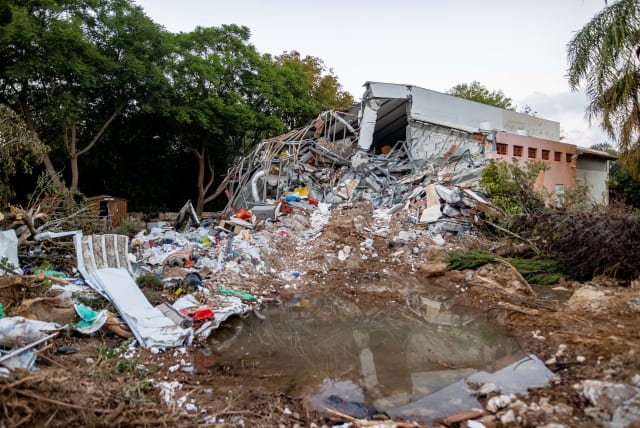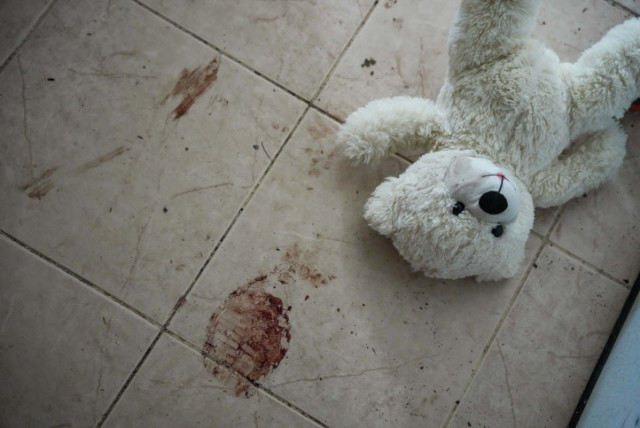Hamas massacre live: Is this what hell looks like? - comment

It was only when I went this week to watch the IDF movie, designed to highlight the horror of that holiday morning that had begun so typically, that the before and after narratives fell into place.
The air was thick with the acrid blend of death, formaldehyde, and the lingering scent of cleaning products. The overpowering smell, the odor of tragedy, threatened to overwhelm me, and I felt as if I might faint.
I had come to Abu Kabir, the forensics institute located in Tel Aviv, where forensic scientists are still working to identify the most mutilated victims of the October 7 Hamas massacre.
It was one of several steps I had taken in the last month to come to grips with the horrifying details of the Hamas attack against southern Israel that was beyond comprehension.
These victims had been so tortured that it was not even possible to understand that one was looking at bodies.
In an examination room, on one bed there sat what appeared to be a Tupperware container.
“What is that?” I asked.
The response I received was chilling: “Flesh,” replied Dr. Nachman Ricardo, head of the Clinical Forensic Unit.
“Like a baby? They burnt a baby.” The box is tiny.
But the answer is no. It is a piece of unidentified flesh – no idea from what part of the body, no picture of who it belonged to.
On the other bed, there lay a sizable trash bag, concealing a chilling sight within – ice and dismembered limbs. In my shock, I asked whose limbs they were.
“Well, we don’t know,” Ricardo responded. “We don’t even know if these are parts from one, two, or more people. People were often tied together and burnt alive – fusing them.”
Ricardo suggested taking me to meet Dr. Tal Simmons, who had come to volunteer from Virginia Commonwealth University. Inside her office, I noticed several tiny cardboard boxes. On top of the one closest to her, there was an inscription: “Kibbutz Amirim, Apt. 3.”
I asked her about the contents of the boxes, and she explained that each box contained the remains of people who died in their apartments.
In other words, these were the remnants of dwellings consumed by fire, incinerated at temperatures of 700 degrees C, with lighter fluid. These were not just charred debris but the bones of individuals. However, identifying whose remains they were was nearly impossible. DNA analysis requires organic material, and the bones had become so desiccated that obtaining such material was uncertain.
“Maybe this one will yield DNA; I’ll set it aside,” Simmons said, picking up a particular round piece. “But if it doesn’t work, we’ll have to keep trying.”
The true extent of the carnage from Hamas's October 7 massacre
Before arriving at Abu Kabir, I had visited the charred remains of the homes where these victims had lived on Israel’s southern border, within eyeshot of the Hamas-controlled Gaza enclave.
At Kibbutz Be’eri and Kfar Aza, less than two weeks after the attack, the pungent odor of death lingered in the air, casting a grim pall over the landscape.
The scenes were profoundly disturbing: a mattress torn by a knife, one side soaked in deep, dark blood, and the other charred to blackness. Blood splatters, staining walls. Bullet holes riddling the surroundings. Ash.
I was running our news desk the day of the massacre, so I knew what had happened. But I did not know.
By my second visit to the South, the devastation had become normalized on the outside. The stories of suffering remained heart-wrenching, but the scene had become just that, a setting in which the people and the small details of their daily lives were missing.
It was only when I went this week to watch the IDF movie, designed to highlight the horror of that holiday morning that had begun so typically, that the before and after narratives fell into place.
THE SCENES it depicted, taken from the body cameras of the terrorists or dashboard cameras of cars, were an unfiltered portrayal of death unfolding.
When the terrorists infiltrated into Israel, the kibbutzim were idyllic and lush, with picturesque roundabouts adorned with flowers and trees. Southern Israel was lovely.
However, the moment the terrorists arrived and their shouts of “Allahu Akbar!” pierced the silence, everything transformed dramatically.
The tranquility was shattered, and a harrowing wave of death ensued. It’s chilling to think about how they opened fire as cars were in motion. The clips taken from the dashboard camera made me feel as if I, myself, were inside the car as the terrorists shot at the moving vehicle – each shot echoing like a deafening drumbeat as the car veered off the road and into a ditch.
I was at the Re’im music festival with these monsters running toward me. I was with a rescue worker with a cellphone approaching the concert bar where dozens of beautiful people lay dead.
“Is anyone here? Is there a sign of life?” he shouted. “Anyone? Anyone?”
Panic surged up to my throat, choking me, mirroring his realization that he was utterly alone.
“I am aghast,” he squeaked. “I am aghast. No one can answer.”
Then, there were two boys and their father running for shelter. A terrorist tossed a grenade into their safe room, and I jolted as the father was thrown against the wall, dead. The children were dragged inside, bloody. One child’s eye was blown out. The other looked like he lost parts of his toes. And they sat there, locked in their own house, screaming, “Daddy! Daddy!” and “I want my mommy.”
The terrorist told them to calm down, then took out a bottle of Coke from their fridge, gulped it down, and walked away.
Blood. So much blood. A hallway full of blood.
Boom. The gun pierced a man’s head. Hack. The axe sliced another man’s neck.
Flip, flip, flip. The image is of a woman’s head burnt like a piece of charcoal after a barbeque, teeth protruding from empty eye sockets. So was the image of hers. And hers. And hers.
And the baby’s.
“Allahu Akbar!” the terrorist shouted into his phone: “Dad, I killed 10 Jews with my bare hands. Mom, your son is a hero.”
What’s most unsettling is that these accounts are just a tiny fraction of the horrific events that transpired. On October 7, thousands of people fell victim to Hamas’ relentless onslaught, with over 5,000 separate incidents occurring.
But it could have been thousands or millions more.
IT WAS only by chance that I was safe in Jerusalem with my family while others in the South were killed. Their living rooms could have been my living room; their kitchens could have been mine because this attack was not on a person, it was on a nation.
The situation depicted in the footage underscored why Israel believes it has no alternative but to take action against Hamas.
The atrocities committed by Hamas have left a deep scar, making it difficult for us to believe we are safe in our homes.
Our ability to live in Israel is at stake; the ground upon which they walked – upon which we walk – trembled on October 7 and still trembles today.
I saw what happened. I saw where it happened. I saw the results of what happened. And I saw who it happened to.
It happened in my home. To me. To my people. To my country. To my future in the State of Israel.
Is this what hell looks like?
As I emerged from the screening of the Hamas massacre footage, a young Government Press Office staffer approached me to hear my reaction. I nodded silently in agreement to be interviewed and moved toward the camera. The young woman extended her microphone.
“Could you please tell me what you witnessed?” she asked.
I attempted to speak, but instead of words, a flood of tears welled up from deep within me. I hadn’t anticipated breaking down, but the emotions were so intense, and the scenes so profoundly distressing, that tears were the only answer. ■
The writer is deputy CEO – strategy and innovation for The Jerusalem Post and a senior correspondent. She also co-hosts the Inside Israeli Innovation podcast.
Jerusalem Post Store
`; document.getElementById("linkPremium").innerHTML = cont; var divWithLink = document.getElementById("premium-link"); if (divWithLink !== null && divWithLink !== 'undefined') { divWithLink.style.border = "solid 1px #cb0f3e"; divWithLink.style.textAlign = "center"; divWithLink.style.marginBottom = "15px"; divWithLink.style.marginTop = "15px"; divWithLink.style.width = "100%"; divWithLink.style.backgroundColor = "#122952"; divWithLink.style.color = "#ffffff"; divWithLink.style.lineHeight = "1.5"; } } (function (v, i) { });

